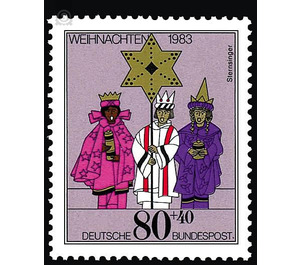Christmas - Germany / Federal Republic of Germany 1983 - 80 Pfennig
| Country | Germany / Federal Republic of Germany |
| Issue Date | 1983 |
| Face Value | 80.00 |
| Color | grey violet |
| Perforation | K 13 3/4: 14 |
| Printing Type | Multicolor offset printing |
| Stamp Type | Postage stamp |
| Item Type | Stamp |
| Chronological Issue Number | 1069 |
| Chronological Chapter | GER-BRD |
| SID | 841350 |
| In 44 Wishlists | |
The Deutsche Bundespost issues the Christmas stamp with a supplement in favor of the "Freie Wohlfahrtspflege", whose organizations help wherever government aid is insufficient. This year, the Christmas brand is in the context of the 25th anniversary of the Sternsinger action and should draw attention to the use of the children's mission work for children's projects in the Third World. Around the turn of the year 1982/1983, there was the 25th time the star singers campaign for children and adolescents in Asia, Oceania, Africa and Latin America. The singing of the stars has its roots in the Bible. The second chapter of the Gospel of Matthew tells that wise men from the East came to Jerusalem and asked, "Where is the newborn King of the Jews? We have seen his star in the east and come to pay homage to him. "The star leads the sages to Bethlehem. There they find the child and Mary, his mother, and they bring their presents to the child: gold, frankincense and myrrh. Probably the three gifts cause the sages to be set to the number "three" since Origines, the Greek church teacher of the third century. Since Caesarius of Arles, they are called "kings." In the 9th century the names "Kaspar", "Melchior" and "Balthasar" can be found. At bishoprics and in monasteries, disciples found the custom of what we now call "star singing" or "three-king singing". Children and adolescents, sometimes adults, are known as the "Three Magi" behind a star bear. They are clothed in garments that according to the imagination of the time and landscape correspond to those of the Three Wise Men, they sing songs that are copied from the biblical texts, they write "mysterious signs" on the door jambs and ask for gifts. These gifts belong to those who gather them, right down to the present century. In 1958, the "Pontifical Missionary Service of Children in Germany" called for the "Three Kings Singing" to be used by children and adolescents in Asia, Oceania, Africa and Latin America. The "star singers" should no longer collect money for their own bag, but help the children in the Third World, that they can live. The idea was initially taken only tentatively, but then found from year to year with more children and adolescents enthusiastic reception. In 1964, the "Association of German Catholic Youth" (BDKJ) joined the action. Since 1980, every year around 10,000 children take part in the campaign. The "Three King Singing" has become a movement that sets new priorities every year: - 1980/1981 was about the lives of the disabled in the Far East, - 1981/1982 to a family program in India and - 1982/1983 to peace. This year, nearly 8,000 communities in the Federal Republic have sent out Sternsinger. That is, at least 210,000 small "kings and beggars" have visited about five million families. From the financial point of view, it is the largest church children's action on earth. At the end of this year's action, it was about DM 95 million that German children and youth gathered for their little sisters and brothers in Asia, Oceania, Africa and Latin America.


